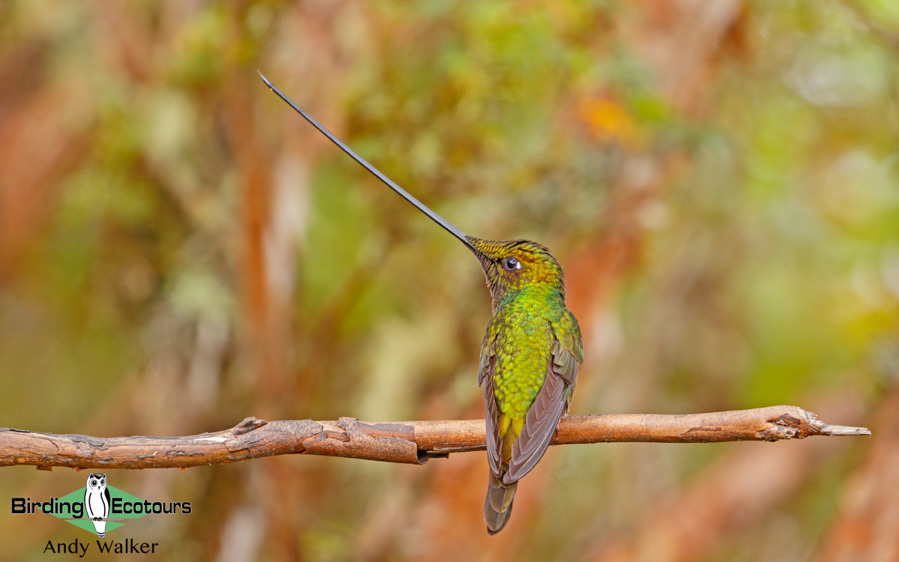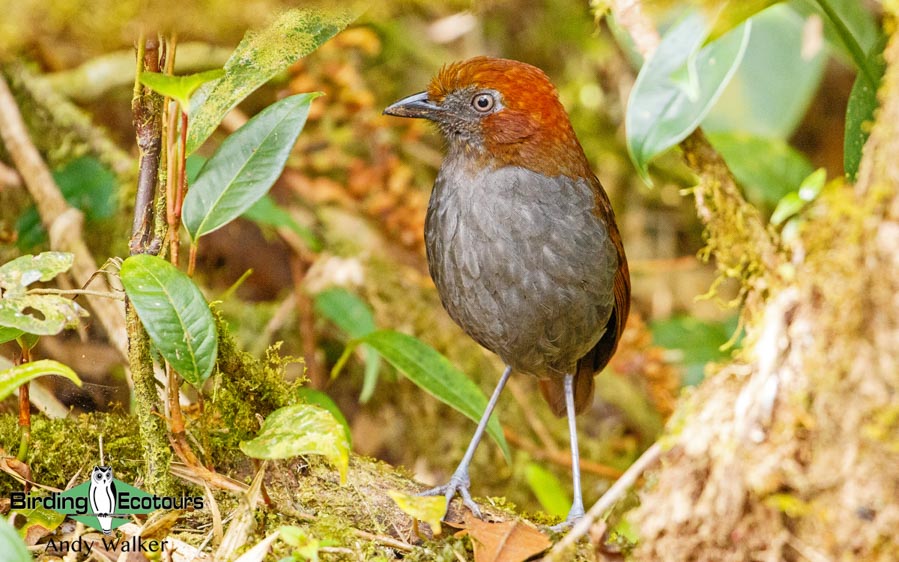Go to All Blogs | Neotropical Blogs | Best time to visit Blogs | Peru Birding Tours | Colombia Birding Tours | All our birding tours
Updated 11 December 2023
Planet Earth’s richest corner for birds: Peru, Colombia and Ecuador
Peru has an incredible bird list of 1890 species, only 103 fewer than similarly sized Colombia, which is famous for boasting more bird species than any other country on earth. However, Peru has 113 endemic bird species (including Marvelous Spatuletail and Long-whiskered Owlet) compared to a nevertheless impressive 84 endemics in Colombia. Both countries are, of course, essential destinations for any world birder.
Eduardo Ormaeche has headed up Birding Ecotours’ South American office from Peru since 2004. This South American office has enabled us to arrange many incredible birding tours to Peru as well as across the rest of the continent and beyond, through Central America and the Caribbean. We do highly recommend the tours that Eduardo himself guides (see our neotropical tour page for more details), but we have other wonderful tour leaders too, of course.
This article deals only with north-western South America, the most bird-diverse corner of the world. Below you will find our recommendations for what time of the year to travel to Peru and Colombia for birding (and other wildlife). We have a separate article for timing of your birding tour to Ecuador, here.
When is the best time of year to visit Peru for birds?
You can enjoy a rewarding birding trip to Peru at any time of the year. But if you travel during the rainy season (December through March being the wettest) then it’s best to avoid the eastern slopes of the Andes and the Amazonian lowlands. Consistent with this recommendation, our set departure Peru birding tours generally run from June through September each year, although we sometimes also offer trips in May and October/November and more rarely at other times of the year. We do this because these are the best months to be in Peru. While the cloud forests and lowland Amazonian forests can be rainy any time of the year, we do of course run our trips when its driest. It’s not because the birds aren’t there, in fact the rainy season (e.g. January) can be wonderful for hummingbirds and other species when more flowers are blooming, but some Manu lodges can flood and high mountain roads can become treacherous.
If you are keen to do Peru for the first time and your plans include visiting the famous Machu Picchu archaeological site, we again recommend you visit during the May to October window. These are months with good weather in the Cusco area and usually allow you to have a whole view of the classic mountain at Machu Picchu.
While most famous as the original capital of the Inca Empire, Cusco also happens to hold incredible bird species. Our Cusco Jewels tour mixes the classic visit of Machu Picchu with some intense birding in the Cusco area that can provide birders with some classic Andean birds such as Andean Condor, Giant Hummingbird, Torrent Duck, White-capped Dipper, Giant Conebill, Plushcap, Andean Goose and Sword-billed Hummingbird. And, the number of range-restricted and localized endemic birds such as Inca Wren, Masked Fruiteater, Royal Cinclodes, Cuzco Brushfinch, Marcapata and Creamy-crested Spinetails, Ash-breasted Tit-Tyrant, Vilcabamba Tapaculo and Bearded Mountaineer to name a few, make the Cusco area worth visiting for any big world lister. Incredible!

Even though the capital of Peru, Lima, has the reputation of being a huge, bustling city with ten million people, Lima can be a good base to explore some natural areas and wildlife refuges that range from sea level to almost 16,400 feet (almost 5,000 meters) in elevation, at the base of the snow-capped mountains. With luck, and with the company of a good birding guide, you can do a quick 4-5-day trip across Lima state and get 19 Peruvian endemics including the outstanding White-bellied Cinclodes, Black-breasted Hillstar, White-cheeked Cotinga, Great Inca Finch, Black-necked Woodpecker and the shy Rufous-breasted Warbling Finch. And, let us not forget Diademed Sandpiper-Plover which can also be seen very high in the mountains west of Lima! Other classic birds of the Lima area include the beautiful Inca Tern (many people think of this as the most beautiful tern on earth), Humboldt Penguin, Peruvian and Blue-footed Boobies and Peruvian Pelican.
Sorry to digress from our recommendations about when the best time is to visit Peru and Colombia. We tend to get excited. Back to the main theme of this blog, which is about timing your birding trip to Peru and Colombia!
When is the best time to go birding in Colombia?
If you are only able to take your birding vacation at a time when Peru is too rainy, then you might well consider Colombia. The best time of the year to visit Colombia is from the end of November to the end of March. We run many of our trips to Colombia, the planet’s richest country for birds (with a staggering bird list only marginally shy of 2,000 species!), in February and March, months that are generally regarded as not being so good in Peru for birding. Fewer birders know that July and August are also dry months in Colombia and we have indeed been known to arrange bespoke birding tours to Colombia in August. However, many North American bird species spend the northern winter in Colombia (more so than in Peru as Colombia is closer to North America), so by doing a trip in the earlier dry season (January/February) you’ll be able to see those migrants as well, on their wintering grounds.
To get a broader experience of Colombia, you will require more than one trip. But exactly what you do depends on whether you just want to get the country experience along with the most representative species of birds, or if you would like to see as many endemics and range-restricted species as possible; in this case we recommend at least three birding tours (see our Colombia birding tours here), to cover this large country.
Colombian feeder stations are well known and visitors may well get perplexed and overwhelmed with the unbelievable number of 63 hummingbird species that can be seen on our classic trip, The Very best of Colombia!
Ecotourism is growing massively in Colombia and you can find hummingbird feeders almost everywhere, and for the antpittas, Colombia has followed the Ecuadorian experience of feeding antpittas, and visiting places such as the Rio Blanco Reserve and Otun-Quimbaya Reserve can almost guarantee you amazingly good sightings of Brown-banded, Chestnut-naped, Slaty-crowned, Chestnut-crowned, Bicolored, Hooded, Rufous and Crescent-faced Antpittas.

Colombia has sovereignty over the San Andres islands, located off the coast of Nicaragua, and their beautiful Caribbean beaches receive a great number of tourists. But, San Andres is also home to the endemic and Vulnerable San Andres Vireo, plus another 206 breeding and migratory species, impressive for such small islands. San Andres can be worth a visit if you want a short weekend birding vacation enjoying the wonderful beaches while adding more endemic species to your lifelist.
The paramos of Bogota, Colombia’s capital, provide unique species such as Green-bearded Helmetcrest, Apolinar’s Wren, Bronze-tailed Thornbill, Black-headed Hemispingus, Noble Snipe and the endemic Bogota Rail. Bogota can also be used as a base to explore several birding spots including the Observatorio de Colibries where you will have outstanding views of Blue-throated Starfrontlet, Glowing Puffleg, Great Sapphirewing and Coppery-bellied Puffleg. The Chicaque Natural Park can provide views of the endemic Golden-bellied Starfrontlet and Black Inca.
It’s also worth mentioning here that Bogota holds the only subspecies of Horned Lark Eremophila alpestris peregrina in South America that occurs completely isolated from the rest of the world population.
Birding the páramos near Bogota also offers you the opportunity to encounter the rare and shy Spectacled Bear! This is the only native bear species in South America and even though it’s widespread in the Andes, encountering this incredible creature can be extremely challenging. Promising news is that several recent sightings in certain areas of the paramos of Bogota can give a chance to see this iconic species. Apparently, the best time of the year to try for this animal is between October and November, when our local guides have reported a surprisingly good number of encounters with this elusive species. This is one of the “ghosts of the Andean cloud forest” as Eduardo has called some rare and elusive species. Partly due to its elevation (almost 7,000 feet, 2640 meters), this generally humid part of the world can have significant rain at any time of the year.
No matter where in Colombia you go, from the Pacific or Caribbean lowlands, right up to the lush cloud forest or the magical páramos in the Andes, Colombia will reward you with a great many birds at any time of the year. But we most recommend the dry season as indicated above.
